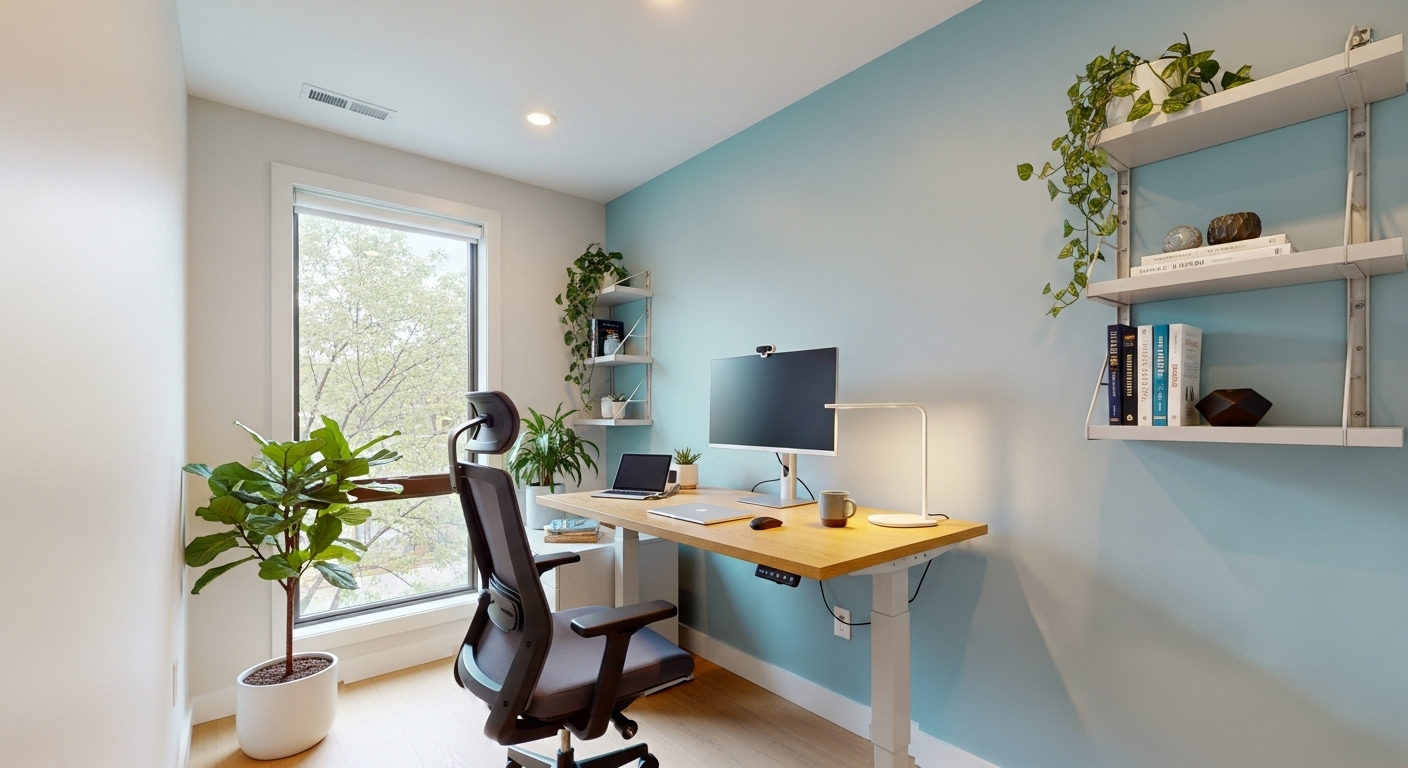The shift to remote work was, for many, a sudden plunge into a new reality. The initial appeal of trading a commute for a few extra steps to the home office was undeniable. Yet, as the months turned into years, the novelty has given way to a more complex set of challenges: blurred boundaries, creeping isolation, and the persistent feeling of being ‘always on.’ The dream of flexibility can quickly curdle into a state of perpetual work. To truly thrive, we must move beyond merely surviving remote work and start architecting it for long-term success. This is the Home-Base Advantage—the conscious and strategic structuring of your physical environment, daily routines, and mental frameworks to create a sustainable, productive, and fulfilling career. This guide will provide a blueprint for transforming your remote setup from a default location into a powerful asset, covering everything from workspace psychology to the digital rituals that reclaim your personal time.
Architecting Your Physical Workspace for Peak Focus
Your physical environment is the most powerful, yet often overlooked, tool in your remote work arsenal. Simply working from the couch or kitchen table creates a psychological overlap that makes it difficult for your brain to switch between ‘work mode’ and ‘rest mode.’ To build a true Home-Base Advantage, you must architect a space dedicated solely to professional focus. This begins with ergonomics—a quality chair, a monitor at eye level, and an external keyboard and mouse are non-negotiable investments in your long-term physical health. Beyond the basics, consider the psychology of your workspace. Research shows that natural light can boost mood and alertness, so positioning your desk near a window can have a tangible impact on your daily energy levels. If you face a distracting view, orient your desk towards a wall to minimize external stimuli. Sound is another critical factor. Invest in noise-canceling headphones to block out household distractions and create a ‘deep work’ cocoon. The most crucial element, however, is a clear physical boundary. Even in a small apartment, using a room divider, a rug, or even a specific lamp that is only turned on during work hours can create a powerful psychological trigger that signals the start and end of your professional day. This designated zone becomes a sanctuary for productivity, allowing the rest of your home to remain a genuine space for relaxation and personal life.
Building Mental Boundaries: Rituals to Start and End Your Day
In a traditional office, the daily commute provides a natural buffer between our professional and personal lives. It’s a period of transition that allows us to mentally prepare for the day ahead and decompress on the way home. Without this built-in separation, the lines blur, and the workday can feel endless. Recreating this boundary with intentional rituals is essential for a sustainable remote career. Start your day not by immediately checking emails, but with a ‘startup ritual.’ This could be a five-minute meditation, stretching, brewing a specific cup of tea, or taking a short walk around the block. This small act signals to your brain that the workday is beginning. Similarly, a ‘shutdown ritual’ is critical. Instead of just closing your laptop and drifting into your evening, create a hard stop. This ritual should involve three key steps: planning for tomorrow (reviewing your calendar and creating a top-three priority list), organizing your digital space (closing all work-related tabs and applications), and performing a physical action that signifies the end of work (turning off your work computer, closing the door to your office). These rituals prevent ‘work creep,’ the slow spillover of professional tasks into personal time. By bookending your day with intention, you reclaim control over your schedule and protect your mental energy for life outside of work, preventing the burnout that plagues so many remote professionals.
Mastering Asynchronous Communication: Clarity Over Constant Contact
One of the biggest pitfalls of remote work is the assumption that it must replicate the constant availability of an in-office environment. This leads to endless notifications, back-to-back video calls, and a culture of reactive communication that shatters focus. The true advantage of remote work lies in mastering asynchronous communication—the art of moving projects forward without requiring everyone to be online at the same time. This requires a fundamental shift from valuing quick responses to valuing clear, comprehensive messages. When you communicate asynchronously, whether in a project management tool like Asana or a chat platform like Slack, your goal should be to provide all the necessary context, links, and action items so your colleague can respond effectively without needing a follow-up call. For example, instead of messaging ‘Hey, got a sec to chat about the Q3 report?’, a better approach is: ‘Regarding the Q3 report draft, I’ve left specific comments in Google Docs on slides 5 and 8. My main concern is the data source for the revenue projection. Can you please review my comments and add the source link by EOD Tuesday? No meeting needed unless you have questions.’ This approach respects your colleagues’ focus time and creates a written record of decisions. Synchronous meetings should be reserved for high-stakes, complex, or relationship-building conversations, not simple status updates. By championing clear asynchronous communication, you reduce digital noise, eliminate unnecessary meetings, and create the deep work windows necessary for high-value output.
The Social Synthesis: Proactively Combating Remote Isolation
While the focus and flexibility of remote work are significant benefits, the lack of spontaneous social interaction can lead to profound feelings of loneliness and disconnection. The casual ‘water cooler’ chats and shared lunches in an office build camaraderie and trust that are difficult to replicate online. Therefore, a successful remote professional must be a proactive architect of their social connections. This goes far beyond mandated virtual happy hours. One effective strategy is to schedule regular, informal one-on-one video calls with teammates with no agenda other than to catch up on a human level. Some companies use apps like Donut, which randomly pair colleagues for virtual coffee chats, systemizing these crucial interactions. Beyond your immediate team, it’s vital to build an external professional network. Engage meaningfully in industry-specific Slack communities or LinkedIn groups. Participate in virtual conferences or webinars, and don’t be afraid to connect with speakers or other attendees afterward. Furthermore, don’t neglect the power of in-person connection. If possible, schedule a day once or twice a month to work from a local coworking space or meet up with other remote professionals in your area. This ‘social synthesis’—blending intentional virtual check-ins with external community building and occasional in-person interaction—creates a robust support system that combats isolation and keeps you connected to your team and your industry.
Investing in Your Invisible Skillset: Self-Discipline and Continuous Learning
In a traditional office, motivation is often an external force. The presence of a manager, the buzz of colleagues working, and a structured environment all provide cues that keep you on task. At home, you are the sole source of your own motivation and discipline. This ‘invisible skillset’ is perhaps the most critical determinant of long-term remote success. Building self-discipline starts with structure. Techniques like time-blocking, where you schedule your entire day in advance, or the Pomodoro Technique, which involves working in focused 25-minute intervals, can provide the framework needed to combat procrastination. It’s also about understanding your own energy cycles and scheduling your most demanding tasks during your peak productivity hours. Beyond daily discipline, career growth in a remote setting requires a proactive approach to learning. Without the ambient learning that happens in an office, you must consciously seek out opportunities for development. This means regularly blocking time in your calendar for online courses, industry reading, or working towards a new certification. It also involves making your progress and skills visible. Proactively share what you’ve learned in team channels or offer to host a lunch-and-learn session. By consistently investing in your self-discipline and actively pursuing new knowledge, you not only enhance your performance but also demonstrate your value and ambition, ensuring you remain a vital, growing member of your team, no matter the distance.
Designing Your Off-Hours: Reclaiming Personal Time and Identity
When your home is also your office, the greatest danger is that work becomes your entire identity. The physical and mental separation is gone, and it becomes deceptively easy to answer one more email at 8 PM or to spend Sunday afternoon ‘just catching up.’ Reclaiming your off-hours is not an indulgence; it is a strategic necessity for preventing burnout and leading a fulfilling life. This requires designing your personal time with the same intention you apply to your workday. Actively schedule hobbies and leisure activities in your calendar. Whether it’s a gym class, a weekly date night, or dedicated time for a creative project, putting it on the schedule elevates its importance and makes you less likely to cancel it for work. Cultivate ‘tech-free’ zones or times in your home. For example, you might have a ‘no screens in the bedroom’ rule or commit to putting your phone away after 7 PM. This creates space for genuine rest and connection. It’s also crucial to have goals and projects completely unrelated to your job. Training for a 5K, learning a new language, or mastering a recipe gives you a sense of accomplishment and identity that is entirely your own. By consciously designing a rich, engaging life outside of your professional obligations, you build resilience. Your work becomes a part of your life, not the entirety of it, which is the ultimate expression of the Home-Base Advantage.
Conclusion
Thriving in a remote work environment is not a matter of chance; it’s a matter of design. The Home-Base Advantage is a holistic framework built on the understanding that your success is intrinsically linked to how you structure your environment, manage your time, and nurture your well-being. It begins with architecting a physical workspace that promotes focus and creating mental boundaries with powerful daily rituals. It thrives on mastering clear, asynchronous communication to reclaim your time and proactively building a network of social connections to combat isolation. Ultimately, it is sustained by a deep investment in your own discipline, a commitment to continuous learning, and the intentional design of a fulfilling personal life outside of your professional identity. By embracing these principles, you can move beyond the common challenges of remote work. You can transform your home base from a simple place of work into a strategic command center for a productive, balanced, and deeply rewarding career. The future of work is not just about where you work, but how you live while you do it. Build your advantage, and you will not only succeed but flourish.





